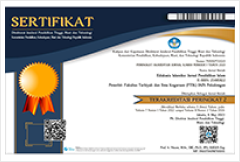PRADAEC Learning Model in Determining the Success of al-Qur’an Hadith Cognitive Learning and as a Religious Moderation Among Students of Islamic Schools
DOI:
https://doi.org/10.28918/jei.v7i2.6242Keywords:
Cognitive Learning Outcome, Al Qur’an Hadith Teaching and Learning, PRADAEC Teaching and Learning Model, Religious ModerationAbstract
Al-Qur'an Hadith are sources of law for Muslims. It is crucial to apply teaching and learning models that are easy for teachers and students to understand and form religious moderation. This study explains how the PRADAEC learning model determines the success of cognitive learning of Islam students while also accommodating religious moderation. Based on the results of this library study, there are seven stages (syntax) in the PRADAEC learning model: Preview, Read, Ask, Discuss, Answer, Explain, and Correction. Second, the seven stages of the PRADAEC learning model are then implemented in three learning components, namely: 1) Introduction, including Preview, 2) core activities, namely Read, Ask, Discuss, Answer and Explain and 3) Closing, namely Correction. Third, the stages (syntax) of the learning process include Preview, Read, Ask, Discuss, Answer, Explain, and Correction. The conditions show that the PRADAEC model improves the cognitive learning of Al-Qur'an Hadith while also accommodating students' religious moderation. The enhancement of local school values such as honesty, mutual respect, and courtesy among students needs to concern the values, assumptions, understandings, beliefs, and expectations that are upheld and used by the school, which determines the behaviors in dealing with internal and external parties.
References
Adi Pratama, Y. A. P., Sopandi, W., & Hidayah, Y. (2019). RADEC Learning Model (Read-Answer-Discuss-Explain And Create): The Importance of Building Critical Thinking Skills In Indonesian Context. IJEVS (International Journal for Educational and Vocational Studies), 1(2), 109–115.
Afroni, S. (2016). Makna ghuluw dalam Islam: Benih ekstrimisme beragama.
Wawasan : Jurnal Ilmiah Agama Dan Sosial Budaya, 1(1), 70–85.
Agusti, D., Rahmatan, H., & Sulastri, S. (2020). Human reproductive system module based on Qur’an and hadith to improve students’ motivation and learning outcomes. Journal of Physics: Conference Series, 1460(1). https://doi.org/10.1088/1742-6596/1460/1/012060
Aminah, S. (2019). Implementasi Model Pembelajaran Cooperative Integrated Reading and Composition Dalam Meningkatkan Kemampuan Membaca Dan Menulis Al Qur’an Siswa Di SDN Tanah KaKedinding V Surabaya. El Banat: Jurnal Pemikiran Dan Pendidikan Islam, 2(9).
Anderson, D. R., & Krathwohl, L. W. (2001). A Taxonomy for Learning Teaching and Assesing (A Revision of Blooms Taxonomy of Educational Objective). https://www.pdf.drive.com/a-taxonomy-for-learning-teaching-and-assessing-a- revision-of-blooms-taxonomy-of-educational-objectives-d187836328.html.
Apriyana, Rusdi, A., & Erlina, D. (2019). Efektivitas Model Pembelajaran Tutor Sebaya untuk Meningkatkan Kemampuan Membaca Al-Quran Siswa pada Mata Pelajaran Al-Quran Hadits di Madrasah Ibtidaiyah Al-Hidayah Palembang. Muaddib: Islamic Education Journal, 2(1), 1–6. https://doi.org/10.19109/muaddib.v2i1.5652
Azra, A. (2020). Moderasi Islam di Indonesia. Kencana.
Destinawati, Rasyid, A., & Syaflin, H. (2022). Pelaksanaan Kurikulum 2013 Pada Mata Pelajaran Al Qur’an Hadits di Madrasah Ibtidaiyah Negeri 6 Kota Padang. PeTeKa (Jurnal Tindakan Kelas Dan Pengembangan Pembelajaran), 5, 90–99. https://doi.org/10.31604/ptk.v5i1.90-99
Fadhilah, Suralaga. (2021). Psikologi Pendidikan. PT. Raja Grafindo Persada.
Fathurrohman, M. (2016). Model-Model Pembelajaran Inovatif. Ar Ruzz Media.
Fuadi, A., Yusri, D., Fakhira, D., Tinggi, S., & Islam, A. (2019). Penerapan Model Pembelajaran Concept Mapping Dalam Meningkatkan Kemampuan Pemahaman Siswa pada Mata Pelajaran Al-Qur’an Hadis: Studi Kasus Kelas Vii MTs. Swasta Tarbiyah Waladiyah Pulau Banyak. Jurnal Dirosah Islamiyah, 1, 108– 122. https://doi.org/10.17467/jdi.v2i2.79
Ghazali, A. M. (2016). Toleransi beragama dan kerukunan dalam perspektif Islam.
Religious : Jurnal Agama Dan Lintas Budaya, 1(1), 25–40.
Hayati, S. (2017). Belajar Dan Pembelajaran Berbasis Cooperative Learning. Graha Cendekia.
Hidajah, R. (2019). Pembelajaran Kooperatif Jigsaw untuk Meningkatkan Aktivitas Belajar Siswa pada Materi Al-Qur’an. EDUTECH, 18(1), 92. https://doi.org/10.17509/e.v18i1.15033
Hosnan, M. (2014). Pendekatan Saintifik dan Kontekstual dalam Pembelajaran Abad
Ghalia Indonesia.
Joyce, B., & Weil, M. (2004). Models of Teaching (D. Steve Dragin, Ed.; 7th Editio).
Pearson Education, Inc.
Kanth, K. R. (2014). Revised Bloom’sTaxonomy,” Thinking.
Kendall, R. J. M. and J. S. (2007). The New Taxonomy of Educational Objectives
(Second Edi). Corwin Press.
KMA 184, “Pedoman Implementasi Kurikulum PAI pada Madrasah” (2019).
Lisawati. (2020). Comparative Study of Islamic Religious Education (PAI) Leraning Management at Elementary School. WARAQAT : Jurnal Ilmu-Ilmu Keislaman, 5(2), 45. https://doi.org/https://doi.org/10.51590/waraqat.v5i2.114.
Mahbub, M. (2021). Analisa Materi Qur’an Hadis Madrasah Aliyah dengan Pendekatan Interdisipliner. Jurnal Ilmu Pendidikan Islam, 19(1), 181–187.
Masnur, M. (2011). Pendidikan Karakter Menjawab: Tantangan Krisis Multidimensional. Bumi Aksara.
Musyaffa, F., Rasyidi, A. H., & Dassucik. (2021). Pengaruh Intensitas Dan Kemandirian Belajar Terhadap Hasil Belajar Peserta Didik Pada Mata Pelajaran IPS Di MTs Fathus Salafi Mangaran. IKA : Ikatan Alumni PGSD UNAIRS 10, No. 2 (2021): 16–27., 10(2), 16–27.
Muzakki, A., Zainiyah, H. S., Rahayu, D. C., & Khotimah, H. (2021). Desain Pembelajaran Model ASSURE Berbasis Multimedia pada Mata Pelajaran al Qur’an Hadits. Edukasi Islami: Jurnal Pendidikan Islam, 10.
Nurdin. (2011). Konsep keadilan dan kedaulatan dalam perspektif Islam dan Barat.
Jurnal Media Syariah, XIII(1), 122.
Purniadi, & Putra, S. (2020). Model Pembelajaran Scramble Untuk Meningkatkan Kemampuan Membaca Al Qur’an Pada Mata Pelajaran Al Quran Hadits di Madrasah Ibtidaiyah (MI) Muhammadiyah Ketapang. Al Mudarris, Journal of Education, 3.
Purwanto. (2014). Evaluasi Hasil Belajar. Pustaka Pelajar.
Rahmiati, Rezi, M., & Zuber, M. (2021). Pengembangan MOdel Inkuiri Sosial Dalam Pembelajaran Al Qur’an Hadits :Penelitian Pengembangan Di Madrasah Tsanawiyah. Jurnal Ilmiah Didaktika, 22(1), 103–122.
Rif’ah, Z., & Rohayati, S. (2015). “Pengaruh Motivasi, Intensitas Belajar dan Penggunaan Modul Terhadap Hasil Belajar Mata Pelajaran Pengantar Akuntansi Keuangan Pada Siwa Kelas X Akuntansi Di SMK Negeri 4 Surabaya,.” Jurnal Pendidikan Ekonomi, No. 2 (2015): 1–9., 2, 1–9.
Rusman. (2016). Model-Model Pembelajaran: Mengembangkan Profesionalisme Guru.
PT. Raja Grafindo Persada.
Sardiman. (2012). Interaksi Dan Motivasi Belajar Mengajar. Raja Grafindo Persada.
Setiyadi, A. C. (2012). Pendidikan Islam Dalam Lingkaran Globalisas. At-Ta’dib, 7(2), 252.
Slameto. (2013). Belajar Dan Faktor-Faktor Yang Mempengaruhinya. Rineka Cipta. Teguh
Saputra, M. (2021). Al-Quran Education Park Teacher Learning Model in Supporting Student Achievement. Devotion : Journal of Community Service, 3(1), 1–8. https://doi.org/10.36418/dev.v3i1.85
Vygotsky. (1978). Mind in Society: The Development of Higher Psychological Processes. Harvard University Press.






















